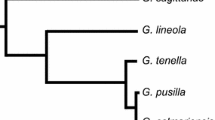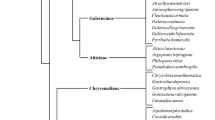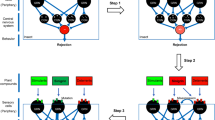Abstract
Chrysomelid beetles offer excellent opportunities for detailed and comparative study of feeding behaviour and of the sensory mechanisms underlying trophic relationships. Many genera contain species with intriguing differences in host affinity, making it possible to compare ecological, behavioural and physiological factors that may contribute to the evolution of variety in host-associations within closely related groups. A number of species can be bred in the laboratory on their host-plants, a necessary prerequisite for many behavioural and physiological experiments.
Access this chapter
Tax calculation will be finalised at checkout
Purchases are for personal use only
Preview
Unable to display preview. Download preview PDF.
Similar content being viewed by others
References
Anderson, J. F. & Metcalf, R., 1986. Identification of a volatile attractant for Diabrotica and Acalymma spp. from blossoms of Curcubita maxima Duchesne. J. Chem. Ecol. 12:687–699.
Barbour, J. D. & Kennedy, G. G., 1991. Role of steroidal glycoal-kaloid alpha-tomatine in host-plant resistance of tomato to Colorado potato beetle. J. Chem. Eol. 17:989–1005.
Bartlet, E. & Williams, I. H., 1991. Factors restricting the feeding of the cabbage stem flea beetle (Psylliodes chrysocephala). Entomologia exp. appl. 60:233–238.
Bodnaryk, R. P., 1991. Developmental profile of sinalbin (phydroxybenzyl glucosinolate) in mustard seedlings, Sinapis alba L., and its relationship to insect resistance. J. Chem. Ecol. 17:1543–1556.
Bodnaryk, R. P. & Lamb, R. J., 1991. Mechanisms of resistance to the flea beetle, Phyllotreta cruciferae (Goeze), in mustard seedlings, Sinapis alba L. Can. J. Plant Sci. 71:13–20.
Bodnaryk, R. P. & Palaniswamy, P., 1990. Glucosinolate levels in cotyledons of mustard, Brassica juncea L. and rape, B. anpus L. do not determine feeding rates of flea beetle, Phyllotreta cruciferae (Goeze). J. Chem. Ecol. 16:2735–2746.
Burgess, L. & Weins, J. E., 1980. Dispensing allyl-isothiocyanate as an attractant for trapping crucifer-feeding flea beetles. Can. Ent. 112:93–97.
Deahl, K. L., Cantelo, W. W., Sinden, S. L. & Sanford, L. L., 1991. The effect of light intensity on Colorado potato beetle resistance and foliar glycoalkaloid concentration of four Solatium chacoense clones. Am. Pot. Journal. 68:659–666.
de Jong, R. & Visser, J. H., 1988a. Specificity related suppression of responses to binary mixtures in olfactory receptors of the Colorado potato beetle. Brain Res. 447:18–24.
de Jong, R. & Visser, J. H, 1988b. Integration of olfactory information in the Colorado potato beetle. Brain Res. 447:18–24.
de Kort, C. A. D. (1990). Thirty-five years of diapause research with the Colorado potato beetle. Entomol. exp. appl. 56:1–13.
Dethier, V. G. 1980. Evolution of receptor sensitivity to secondary plant substances with special reference to deterrents. Am. Nat. 115:45–66.
Dickens, J. C. & Boldt, P. E. 1985. Electroantennogram responses of Trirhabda bacharides (Weber) (Coleoptera: Chrysomelidae) to plant volatiles. J. Chem. Ecol. 11:767–779.
Feeny, P., Paauwe, K. L., & Demong, N. J. 1970. Flea beetles and mustard oils: host plant specificity of Phyllotreta cruciferae and P. striolata adults (Coleoptera: Chrysomelidae). Ann. ent. Soc. Am. 63:832–841.
Fox, L. R. & Morrow, P. A. 1981. Specialization: species property or local phenomenon. Science 211:887–893.
Gerber, G. H. & Obadofin, A. A. 1981. Growth, development and survival of the larvae of the red turnip beetle, Entomoscelis americana (Coleoptera: Chrysomelidae), on Brassica campestris and B. napus (Cruciferae). Can. Ent. 113:395–406.
Haley Sperling, J. L. & Mitchell, B. K. 1991. A comparative study of host recognition and the sense of taste in Leptinotarsa. J. exp. Biol. 157:439–459.
Hanson, F. E. & Peterson, S. C. 1990. Sensory coding in Manduca sexta for deterrence by a non-host plant Canna generalis. Symp. Biol. Hung. 39:29–37.
Hare, J. D. 1983. Seasonal variation in plant-insect associations: utilization of Solanum dulacamra by Leptinotarsa decemlineata. Ecology 64:345–361.
Hare, J. D., 1987. Growth of Leptinotarsa decemlineata larvae in response to simultaneous variation in protein and glycoalkaloid concentration. J. Chem. Ecol. 13:39–46.
Hare, J. D. & Dodds, J. A., 1987. Survival of the Colorado potato beetle on virus-infected tomato in relation to plant nitrogen and alkaloid content. Entomol. exp. appl. 44:31–35.
Harrison, G. D., 1987. Host-plant discrimination and evolution of feeding preference in the Colorado potato beetle Leptinotarsa decemlineata. Physiol. Ent. 12:407–415.
Harrison, G. D. & Mitchell, B. K. 1988. Host-plant acceptance by geographic populations of the Colorado potato beetle. Leptinotarsa decemlineata. Role of solanaceous alkaloids as sensory deterrents. J. Chem. Ecol. 14:777–788.
Hicks, K. L. 1974. Mustard oil glucosides: Feeding stimulants for adult cabbage flea beetles, Phyllotreta cruciferae (Coleoptera: Chrysomelidae). Ann. ent. Soc. Am. 67:261–264.
Hsiao, T. H. 1986. Specificity of certain chrysomelid beetles for Solanaceae. In: D’Arcy, W. G. (ed.); Solanaceae: Biology and Systematics, Columbia Univ. Press, N.Y. pp. 345–363.
Hsiao, T. H. 1988. Host specificity, seasonality and bionomics of Leptinotarsa beetles. In: Jolivet, P., Petitpierre, E. and Hsiao, T. H. (eds.); Biology of Chrysomelidae. Kluwer Academic Pub. pp. 581–599.
Jermy, T., Szentesi, A. & Horvath, J. 1988. Host plant finding in phytophagous insects: the case of the Colorado potato beetle. Entomol. exp. appl. 49:83–89.
Jolivet, P. 1988. Food habits and food selection of Chrysomelidae. Bionomic and evolutionary perspectives. In: Jolivet, P., Petitpierre, E. and Hsiao, T. H. (eds.); Biology of Chrysomelidae. Kluwer Academic Pub. pp. 1–23.
Koritsas, V. M., Lewis, J. A. & Fenwick, G. R. 1991. Glucosinolate responses of oilseed rape, mustard and kale to mechanical wounding and infestation by cabbage stem flea beetle (Psylliodes chrysocephala). Ann. appl. Biol. 118:209–221.
Lamb, R. J. 1988. Susceptibility of low-and high-glucosinolate oilseed rape to damage by flea beetles, Phyllotreta spp. (Coleoptera: Chrysomelidae). Can. Ent. 120:195–196.
Lamb, R. J., 1989. Entomology of oilseed Brassica crops. Ann. Rev. Entomol. 34:211–229.
Lamb, R. J. & Palaniswamy, P., 1990. Host discrimination by a crucifer-feeding flea beetle, phyllotreta striolata (F.) (Coleoptera: Chrysomelidae). Can. Ent. 122:817–824.
Larsen, L. M., Nielsen, J. K., Ploger, A. & Sorensen, H., 1985. Responses of some beetle species to varieties of oil seed rape and to pure glucosinolates. World Crops Prod. Util. Desa. The Hague. 11:230–244.
Ma, W. C. & Visser, J. H. 1978. Single unit analysis of odour quality coding by the olfactory antennal receptor systems of the Colorado beetle. Ent. exp. appl. 24:520–533.
Matsuda, K. 1988. Feeding stimulants of leaf beetles. In: Jolivet, P., Petitpierre, E. and Hsiao, T. H. (eds.); Biology of Chrysomelidae. Kluwer Academic Pub. pp. 41–56.
May, M. L. & Ahmad, S. 1983. Host location in the Colorado potato beetle: searching mechanisms in relation to oligophagy. In: Ahmad, S (ed.) Herbivorous Insects, Host Seeking Behavior and Mechanisms. Academic Press, N.Y. pp. 173–199.
Mitchell, B. K. 1985. Specificity of an amino acid-sensitive cell in the adult Colorado beetle, Leptinotarsa decemlineata. Physiol. Ent. 10:421–429.
Mitchell, B. K. 1987. Interactions of alkaloids with galeal chemosensory cells of Colorado potato beetle. J. Chem. Ecol. 13:2009–2022.
Mitchell, B. K. 1988. Adult leaf beetles as models for exploring the chemical basis of host-plant recognition. J. Insect Physiol. 34:213–225.
Mitchell, B. K. & Gregory, P. 1979. Physiology of the maxillary sugar sensitive cell in the red turnip beetle, Entomoscelis americana. J. Comp. Physiol. 132:167–178.
Mitchell, B. K. & Gregory, P. 1981. Physiology of the lateral galeal sensillum in red turnip beetle larvae (Entomoscelis americana Brown): Responses to NaCl, Glucosinolates and other Glucosides. J. Comp. Physiol. 144:495–501.
Mitchell, B. K. & Harrison, G. D., 1984. Characterization of galeal chemosensilla in the adult Colorado beetle, Leptinotarsa decemlineata. Physiol. Ent. 9:49–56.
Mitchell, B. K. & Harrison, G. D., 1985. Effects of Solanum glycoalkaloids on chemosensilla in the Colorado potato beetle. A mechanism of feeding deterrence? J. Chem. Ecol. 11:73–83.
Mitchell, B. K., McCashin, B. & Albert, P. J., 1989. Host volatiles as gustatory stimuli for phytophagous insects. Chem. Senses 14:729.
Mitchell, B. K., Rolseth, B. M. & McCashin, B. G., 1990. Differential responses of galeal gustatory sensilla of the adult Colorado potato beetle, Leptinotarsa decemlineata (Say), to leaf saps from host and non-host plants. Physiol. Ent. 15:61–72.
Mitchell, B. K. and Sutcliffe, J. F. 1984. Sensory inhibition as a mechanism of feeding deterrence: effects of three alkaloids on leaf beetle feeding. Physiol. Ent. 9:57–64.
Morrow, P. A., Tonkyn, D. W. & Goldburg, R. J. 1989. Patch colonization by Trirhabda canadensis (Coleoptera: Chrysomelidae): effects of plant species composition and wind. Oecologia 81:43–50.
Nielsen, J. K., 1978, host plant discrimination within cruciferae: feeding responses of four leaf beetles (Coleoptera: Chrysomelidae) to glucosinolates, cucurbitacins and cardenolides. Ent. exp. appl. 24:41–54.
Nielsen, J. K. 1988. Crucifer-feeding Chrysomelidae: mechanisms of host plant finding and acceptance. In: Jolivet, P., Petitpierre, E. and Hsiao, T. H. (eds.); Biology of Chrysomelidae. Kluwer Academic Pub.
Nielsen, J. K. 1989. The effect of glucosinolates on responses of young Phyllotreta nemorum larvae on non-host plants. Entomol. exp. appl. 51:249–259.
Puttick, G. M., Morrow, P. A. & Lequesne, P.W. 1988. Trirhabda canadensis (Coleoptera: Chrysomelidae) responses to plant odors. J. Chem. Ecol. 14:1671–1686.
Ritcey, G. M. & McIver, S. B. 1990. External morphology of antennal sensilla of four species of adult flea beetles (Coleoptera: Chrysomelidae: Alticinae). Int. J. Insect Morphol. & Embryol. 19:141–153.
Schoonhoven, L. M. 1982. Plant recognition by lepidopterous larvae. Symp. R. Entomol. Soc. London. 6:87–99.
Sen. A., 1987. Structure and function of palpi in the Colorado potato beetle, Leptinotarsa decemlineata. Ph.D. thesis, University of Alberta, 132 pp.
Sen. A., 1988. Ultrastructure of the sensory complex on the maxillary and labial palpi of the Colorado potato beetle, Leptinotarsa decemlineata. J. Morphol. 195:159–175.
Sen, A. & Mitchell, B. K., 1987. Ultrastructure of the galeal sensory complex in adults of the Colorado potato beetle, Leptinotarsa decemlineata. Physiol. Ent. 12:81–90.
Sinden, S. L., Sanford, L. L., Cantelo, W. W. & Deahl, K. L., 1986. Leptine glycoalkaloids and resistance to the Colorado potato beetle (Coleoptera: Chrysomelidae) in Solanum chacoense. Environ. Ent. 15:1057–1062.
Sutcliffe, J. F. & Mitchell, B. K., 1980. Structure of galeal sensory complex in adults of the red turnip beetle, Entomoscelis americana Brown (Coleoptera, Chrysomelidae). Zoomorphology 96:63–76.
Sutcliffe, J. F. & Mitchell, B. K., 1982. Characterization of galeal sugar and glucosinolate-sensitive cells in Entomoscelis americana adults. J. Comp. Physiol. 146:393–399.
Thiery, D. & Visser, J. H, 1986. Masking of host odour in the olfactory orientation of the Colorado potato beetle. Ent. exp. appl. 41:165–172.
Thiery, D. and Visser, J. H. 1987. Misleading the Colorado potato beetle with an odor blend. J. Chem. Ecol. 13:1139–1146.
Vincent, C. and Stewart, R. K. 1984. Effect of allyl isothiocyanate on field behaviour of crucifer-feeding flea beetles (Coleoptera: Chrysomelidae). J. Chem. Ecol. 10:33–39.
Visser, J. H. and Ave, D. A. 1978. General green leaf volatiles in the olfactory orientation of the Colorado beetle Leptinotarsa decemlineata. Ent. exp. appl. 24:738–749.
Visser, J. H. and Nielsen, 1977. Specificity in the olfactory orientation of the Colorado potato beetle, Leptinotarsa decemlineata. Ent. exp. appl. 21:14–22.
Visser, J. H. and de Jong, R. 1988. Olfactory coding in the perception of semiochemicals. J. Chem. Ecol. 14:2005–2018.
Author information
Authors and Affiliations
Editor information
Rights and permissions
Copyright information
© 1994 Springer Science+Business Media Dordrecht
About this chapter
Cite this chapter
Mitchell, B.K. (1994). The chemosensory basis of host-plant recognition in Chrysomelidae. In: Jolivet, P.H., Cox, M.L., Petitpierre, E. (eds) Novel aspects of the biology of Chrysomelidae. Series Entomologica, vol 50. Springer, Dordrecht. https://doi.org/10.1007/978-94-011-1781-4_7
Download citation
DOI: https://doi.org/10.1007/978-94-011-1781-4_7
Publisher Name: Springer, Dordrecht
Print ISBN: 978-94-010-4783-8
Online ISBN: 978-94-011-1781-4
eBook Packages: Springer Book Archive




